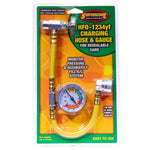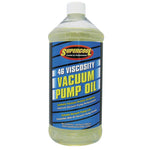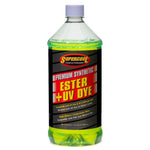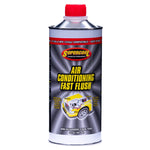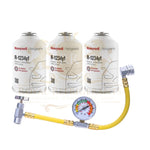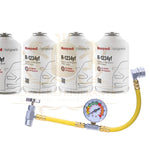You have no items in your shopping cart.
Everything You Need to Know About HFC Refrigerant for HVAC and Automotive Applications
In the world of air conditioning and refrigeration, HFC refrigerants (Hydrofluorocarbons) have been a cornerstone of modern cooling technology for decades. Used extensively in HVAC systems, automotive A/C, and refrigeration equipment, HFCs replaced older, ozone-depleting refrigerants like CFCs and HCFCs.
But as global environmental regulations evolve, HFCs are now being phased down in favor of newer, more eco-friendly alternatives.
This article explains what HFC refrigerants are, how they work, their advantages and drawbacks, and their role in both HVAC and automotive applications — along with what’s next in refrigerant evolution.
What Is an HFC Refrigerant?
HFC (Hydrofluorocarbon) refrigerants are synthetic compounds made up of hydrogen, fluorine, and carbon atoms.
They were developed as non-ozone-depleting substitutes for CFCs (Chlorofluorocarbons) and HCFCs (Hydrochlorofluorocarbons), which were phased out under the Montreal Protocol due to their harmful effects on the ozone layer.

🧪 Common HFC Refrigerants
| Refrigerant | Typical Application | Global Warming Potential (GWP) | Notes |
|---|---|---|---|
| R134A | Automotive A/C, chillers | 1,430 | Popular in cars before R1234yf |
| R410A | Residential & commercial HVAC | 2,088 | Widely used in split and package units |
| R404A | Commercial refrigeration | 3,922 | Common in supermarkets/freezers |
| R407C | Air conditioning systems | 1,774 | Retrofit option for R22 |
| R507A | Industrial refrigeration | 3,985 | Replacement for R502 |
All of these refrigerants are non-ozone-depleting but have high Global Warming Potentials (GWPs) — making them contributors to climate change if leaked into the atmosphere.
Chemical Properties of HFCs
| Property | Description |
|---|---|
| Chemical Structure | Hydrogen (H), Fluorine (F), and Carbon (C) |
| Ozone Depletion Potential (ODP) | 0 |
| Global Warming Potential (GWP) | High (typically 1,000–4,000) |
| ASHRAE Safety Classification | A1 (Non-flammable, low toxicity) for most HFCs |
| Form | Colorless, non-corrosive gases or liquids |
| Lubricant Compatibility | Use POE (Polyolester) oils in most systems |
HFCs are stable, efficient, and safe to handle — which explains their widespread use across residential, commercial, and automotive sectors.
How HFC Refrigerants Work
HFC refrigerants operate on the same vapor-compression refrigeration cycle as other refrigerants:
- Compression – The refrigerant gas is compressed, raising its temperature and pressure.
- Condensation – It releases heat and condenses into a liquid.
- Expansion – The high-pressure liquid passes through an expansion valve, dropping in pressure and temperature.
- Evaporation – It absorbs heat from the environment, providing cooling.
Their thermodynamic properties (high latent heat and efficiency) made HFCs a natural replacement for older refrigerants.
Why HFCs Replaced CFCs and HCFCs
| Comparison | CFCs (e.g. R12) | HCFCs (e.g. R22) | HFCs (e.g. R134A, R410A) |
|---|---|---|---|
| Ozone Depletion Potential | High | Moderate | Zero |
| GWP | Moderate | High | Very High |
| Environmental Regulation | Banned (global) | Phased out (by 2020) | Currently being phased down |
| Applications | Old A/C, refrigeration | Legacy HVAC systems | Modern HVAC & automotive |
HFCs represented a major environmental improvement over ozone-depleting refrigerants — but their high GWPs have made them the next target for global climate policies.
HFC Refrigerants in HVAC Applications
HFCs have dominated the HVAC industry for more than two decades.
Common Uses:
- R410A in residential and commercial split systems
- R407C as a retrofit for R22 systems
- R404A/R507A in supermarket and commercial refrigeration
- R134A in chillers and medium-temperature systems
Benefits for HVAC:
✅ Excellent energy efficiency
✅ Safe and non-flammable (A1 classification)
✅ Compatible with modern compressor oils
✅ Readily available and well understood by technicians
However, due to regulatory pressure, new systems are now shifting toward HFO blends (like R32, R454B, R466A) and natural refrigerants (CO₂, ammonia, propane).
HFC Refrigerants in Automotive Applications
In automotive A/C, R134A became the global standard in the 1990s, replacing ozone-depleting R12. It provided:
- Strong cooling performance
- Non-flammable safety
- Compatibility with small systems
However, R134A’s GWP of 1,430 has made it a target for replacement.
Modern vehicles now use R1234yf (HFO), which has a GWP of less than 1, making it far more climate-friendly.
Comparison – Automotive Refrigerants
| Property | R12 | R134A | R1234yf |
|---|---|---|---|
| Type | CFC | HFC | HFO |
| ODP | 1.0 | 0 | 0 |
| GWP | 10,900 | 1,430 | <1 |
| Status | Banned | Phasing out | Current standard |
Even though R134A is still common in older vehicles, R1234yf is now mandated in most new cars in the U.S., EU, and many other regions.
Environmental Impact of HFC Refrigerants
While HFCs do not damage the ozone layer, they have high global warming potentials, trapping heat in the atmosphere.
For example:
- 1 kg of R410A released = the CO₂ impact of over 2 tons of carbon dioxide.
This is why international agreements like the Kigali Amendment to the Montreal Protocol (2016) are targeting an 85% reduction in HFC production and consumption by 2036.
Regulations and Phase-Down of HFCs
🌍 Global Regulations
- Kigali Amendment: Mandates global HFC phase-down.
- Montreal Protocol: Extended to cover HFCs due to their GWP impact.
🇺🇸 United States (EPA AIM Act)
- The AIM Act (American Innovation and Manufacturing Act) requires phased reductions in HFCs by 85% by 2036.
- New HVAC systems using R410A and similar high-GWP refrigerants will be restricted from 2025 onward.
- EPA Section 608 certification is required for anyone handling HFC refrigerants.
🇪🇺 European Union (F-Gas Regulation)
- Strong HFC quotas and bans on high-GWP refrigerants in new equipment.
- Targets near-total elimination of high-GWP refrigerants by 2030.
Next-Generation Alternatives to HFCs
| Refrigerant | Type | GWP | ODP | Applications |
|---|---|---|---|---|
| R32 | HFO/HFC (A2L) | 675 | 0 | Split A/C, heat pumps |
| R454B (Puron Advance) | HFO/HFC | 466 | 0 | R410A replacement |
| R466A | HFO blend | 733 | 0 | Commercial HVAC |
| R513A | HFO/HFC | 631 | 0 | Chillers |
| R1234yf | HFO | <1 | 0 | Automotive A/C |
| R744 (CO₂) | Natural | 1 | 0 | Commercial, automotive |
| R290 (Propane) | Natural | 3 | 0 | Residential & light commercial |
These alternatives offer similar performance with significantly lower GWPs, aligning with global environmental goals.
Safety and Handling of HFC Refrigerants
Even though HFCs are generally safe, proper handling is essential:
- Always recover and recycle refrigerant — venting is illegal.
- Use EPA-certified recovery equipment.
- Store in approved, clearly labeled cylinders.
- Train technicians under Section 608/609 (U.S.) or equivalent certification.
- Monitor for leaks regularly using approved leak-detection methods.
Summary Table
| Feature | HFC Refrigerants |
|---|---|
| Chemical Type | Hydrofluorocarbons |
| ODP | 0 |
| GWP | High (1,000–4,000) |
| Safety | A1 – Non-flammable, low toxicity |
| Typical Examples | R134A, R410A, R404A, R407C |
| Applications | HVAC, refrigeration, automotive A/C |
| Phase-Down | Under global Kigali & AIM regulations |
| Alternatives | HFO blends, CO₂, hydrocarbons |
Final Thoughts
HFC refrigerants transformed the cooling industry by eliminating ozone damage — but their high global warming potential has made them the next phase-out target.
For both HVAC and automotive professionals, understanding HFCs is essential to:
- Maintain existing systems responsibly,
- Stay compliant with refrigerant management regulations, and
- Prepare for the transition to low-GWP refrigerants like R32, R454B, and R1234yf.
The future of refrigeration is greener, but knowing the role of HFCs helps us appreciate how far the industry has come — and where it’s headed next.
 English
English

